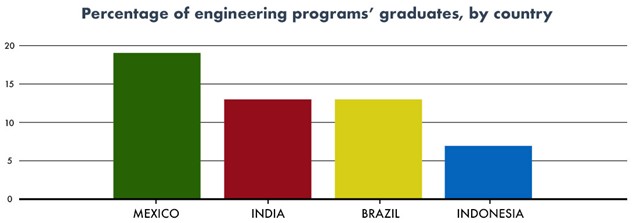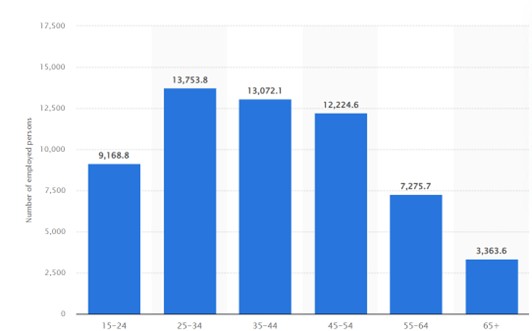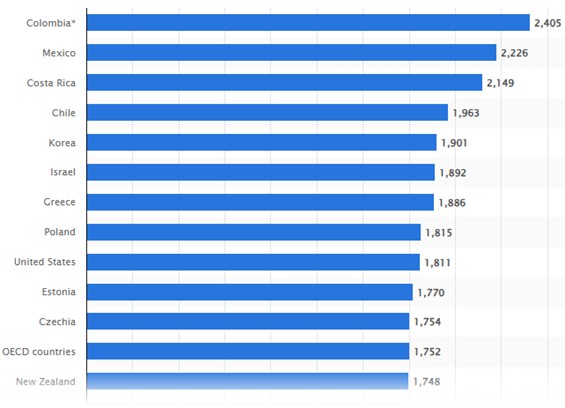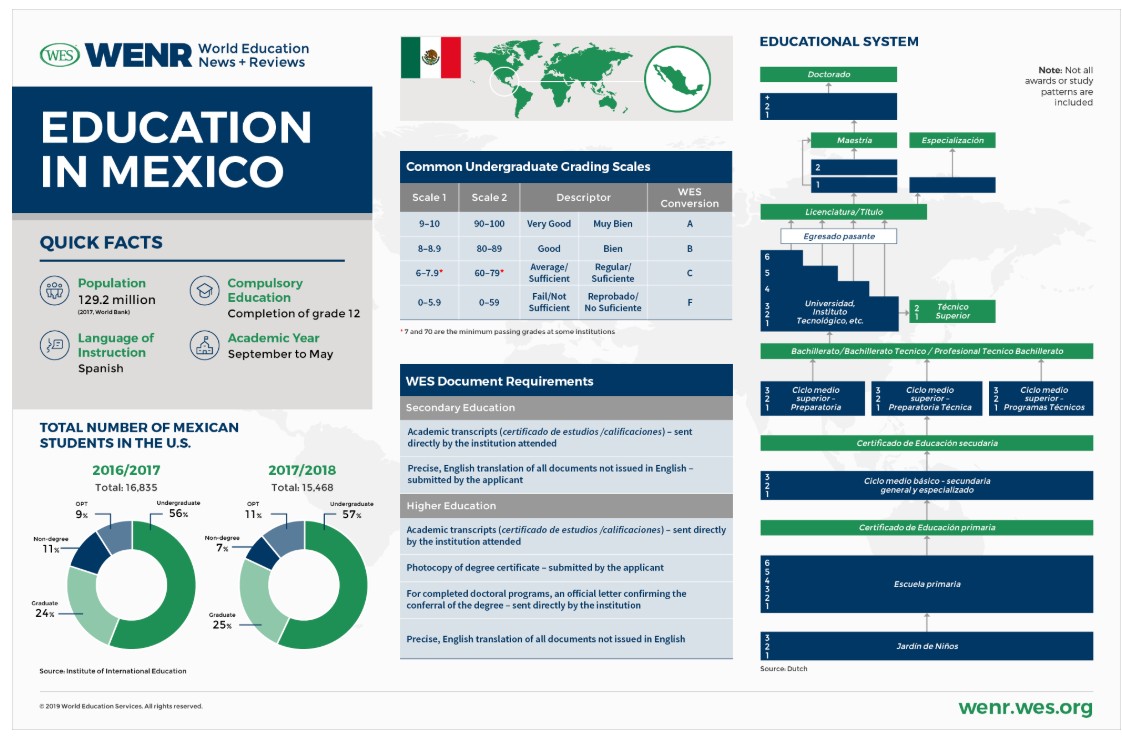Educated Workforce
Mexico has abundant young and skilled workforce, particularly in the areas of engineering, information technology, and manufacturing. Thanks to its proximity to the United States, the main cities are very developed with educated workforce with a young generation who speak English, and many of them visit well-known universities which have partnerships with I international schools worldwide.
Some Hard Facts
- 130,000 engineers graduate in Mexico each year.
- Mexico produces nearly double the number of engineer graduates compared to Canada, Germany, and Brazil combined.
- Mexico's workforce ranks among the top 10 globally, according to an international study.
- In Latin America, Mexico has the second-highest number of software engineers, with Brazil being the only country ahead in this regard.
White Collar
Over the last years, the quality of Mexican labor has been improving consistently. This due to the reason that the government has made it a priority to invest in the education and training of its workforce after leaving school; Moreover, thanks to the proximity to the United States, these individuals are familiar with the culture of both countries and are bilingual. And this helps them respond better to the needs of US companies.

As you can see in the graph above, the country now has vast talent pools that are well-versed in the latest technologies. This is due to the reason that Mexicans have a strong work ethic and are eager to improve their skills and knowledge, which is invaluable to businesses. Besides that, they can be hired to much more affordable rates compared to the United States and Canada, providing significant cost savings for businesses.
The use of automation, robotics six sigma, lean, ISO and other industry-specific quality standards are commonplace in Mexico, and many of the leading manufacturing innovations implemented worldwide are coming from factories in Mexico. As they are located in between the South and North America countries and many are bilingual (Spanish and English), they can efficiently distribute with their 64 airports and modern infrastructure the whole continent at low costs.
Blue Collar

Beside the skilled labor force, most employees work in large fabrication and execute tasks that are done by hand, typically involving physical effort and manual skills. This can be in the areas such as construction, crafts, or any other situation where work is performed manually rather than using machinery or automation. The term used in Mexico is “Obra de mano” and the earnings are between 500 – 700 dollars monthly.
Thus, Mexico is an appealing destination thanks to its advantageous cost structure, including factors such as lower wages and operational expenses, and provides companies with a strategic opportunity to achieve lower manufacturing costs and maintain competitive pricing for their products.
Young working population
Mexico boasts a young and industrious workforce, a key factor that positions it as an attractive destination for nearshoring. Indeed, with an average age of around 29 years, it is significantly lower than countries like Germany (45 years), the United States (39 years), or China (38 years). This demographic composition ensures a continuous influx of labor into the market, mitigating concerns related to an aging workforce and provides a steady supply of workers, ensuring long-term labor availability and reducing the risks of labor shortages seen in aging economies.

For manufacturers and investors, Mexico's young workforce means higher productivity, adaptability to new technologies, and a lower dependency ratio, making it an attractive destination for businesses seeking long-term stability and growth.
Working hours of 40 – 48 hours
Mexico ranks second among OECD countries in annual working hours (2,226). Labor unions support a gradual transition, but economists warn it may lead to fewer formal jobs and a rise in informal employment. The informal sector already accounts for 55.1% of Mexico’s workforce and nearly 30% of GDP.

A bill in Mexico’s Congress seeks to reduce the legal workweek from 48 to 40 hours, sparking debate. Supporters argue it dignifies workers and improves work-life balance, while critics warn of economic harm, reduced hiring, and lower productivity. The bill, which requires a two-thirds majority to amend Article 123 of the Mexican Constitution, is set for debate in February.
Opponents fear reduced hours could lower wages and bonuses, impacting worker earnings. While Latin America’s largest economies maintain workweeks of 42–48 hours, Ecuador and Chile have already adopted 40-hour workweeks. Advocates argue the change would reduce workplace injuries and enhance quality of life, particularly for maquiladora workers.
Mexican Universities
A Mexican engineer with a degree from one of the top 20 universities in Mexico will have similar technical education. However, Mexicans respond to the world in a different way than Americans, as their leadership style is different, and the way they interact to the people is more personal. Thus, a well-prepared engineer, a Mexican one will do and add to your multicultural team.

Over the last five years, an average of 130,000 engineers and technicians have graduated each year from Mexican universities and specialized high schools which guarantees the flow of specialized human talent. Engineers increased from 1.1 million to just 1.3 million in recent years. In addition, there were almost 30’000 science graduates in Mexico in 2015, with a total enrollment of around 194’000.
Mexican Universities with worldwide partnerships
For a Mexican, it is not difficult to find a graduate program in North America and Western Europe. Mexico’s educational system bridges gaps between the knowledge received in high school and that obtained through a college degree.
It is becoming more common, among Mexico’s middle class, to study abroad. Federal and state-funded schools like the Insituto Tecnologico (IT) and Universidad Tecnologica (UT) offer trade-specific skills development and degrees similar to those found in the U.S. community college system. According to Pew Research Center, 36.6 million Mexican lived in 2017 in the USA – many return with a University degree back to Mexico. In general, Mexican Universities offer similar degrees like those which can be found in the USA community college system.
Many of workforce visit well-known universities which have partnerships with international schools worldwide. Indeed, Mexico graduates many more engineers than United States yearly.
- Strong manufacturing experience: Mexico benefits from a long history in the automotive industry, spanning over 30 years, resulting in a wealth of manufacturing expertise.
- Access to education: Approximately 30% of Mexicans, totaling around 40 million people, have access to education, and less than 20% of the entire population holds a degree.
- English language proficiency: Due to its proximity to the United States, a significant number of Mexicans are fluent in English.
- Positive demographic process: Mexico exhibits a positive demographic trend, with a higher working-age population compared to the dependent population (those aged 0 to 14 years and 65 years and over), which contributes to the country's productive and economic potential.
- Abundant pool of talented workers: Mexico boasts a large pool of skilled operational workers and managers who can make a significant positive impact for international companies.
Mexicans Universities
The top Mexican institutions included in international university rankings include the National Autonomous University of Mexico and the private Monterrey Institute of Technology and Higher Education. Other well-known Universities are:
- The Monterrey Institute of Tertiary Education and Technology (ITESM)
- Anahuac University
- UNAM
- Instituto Politecnico Nacional
- Metropolitan Autonomous University
- the Autonomous University of Querétaro
- the Instituto Politécnico Nacional
- Universidad Anáhuac
Workforce Conditions in Mexico
The workforce conditions in Mexico are compared to other countries very competitive, here the main facts:
- Work hours per week: 48 -
- Holidays: 12 days after the 1st year of work
- Minimum wage: $10.50 dollars per day
- Average wage: 500 - $700 dollars / month
- 150,000 engineers graduate from a university each year




